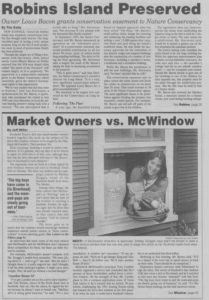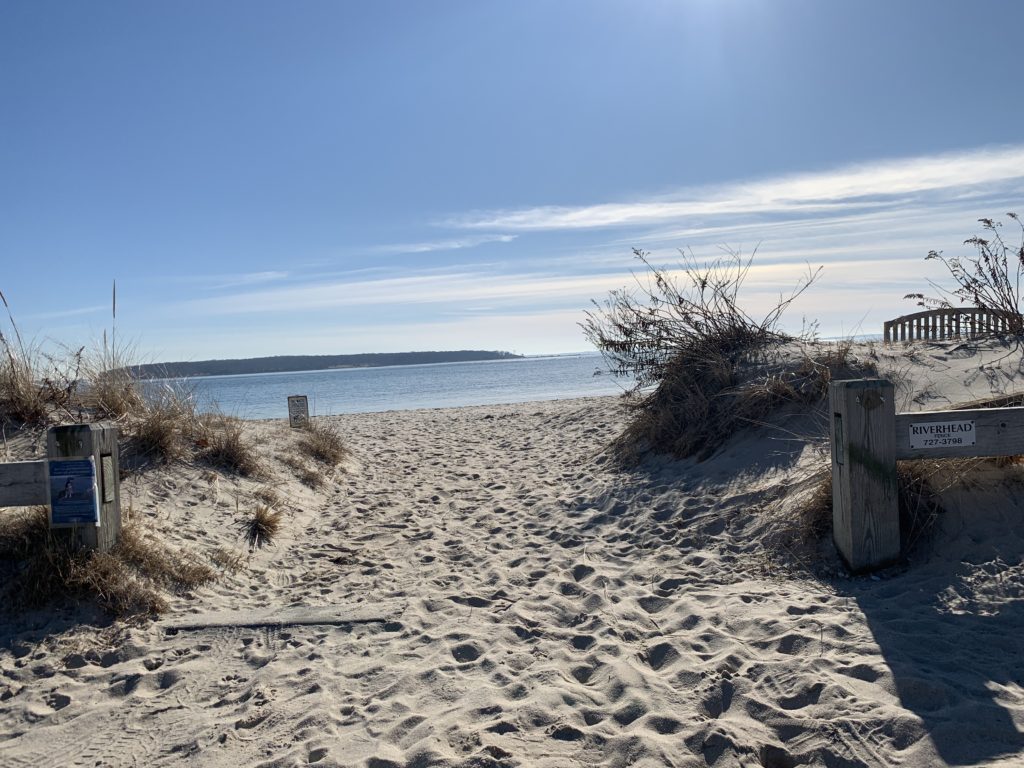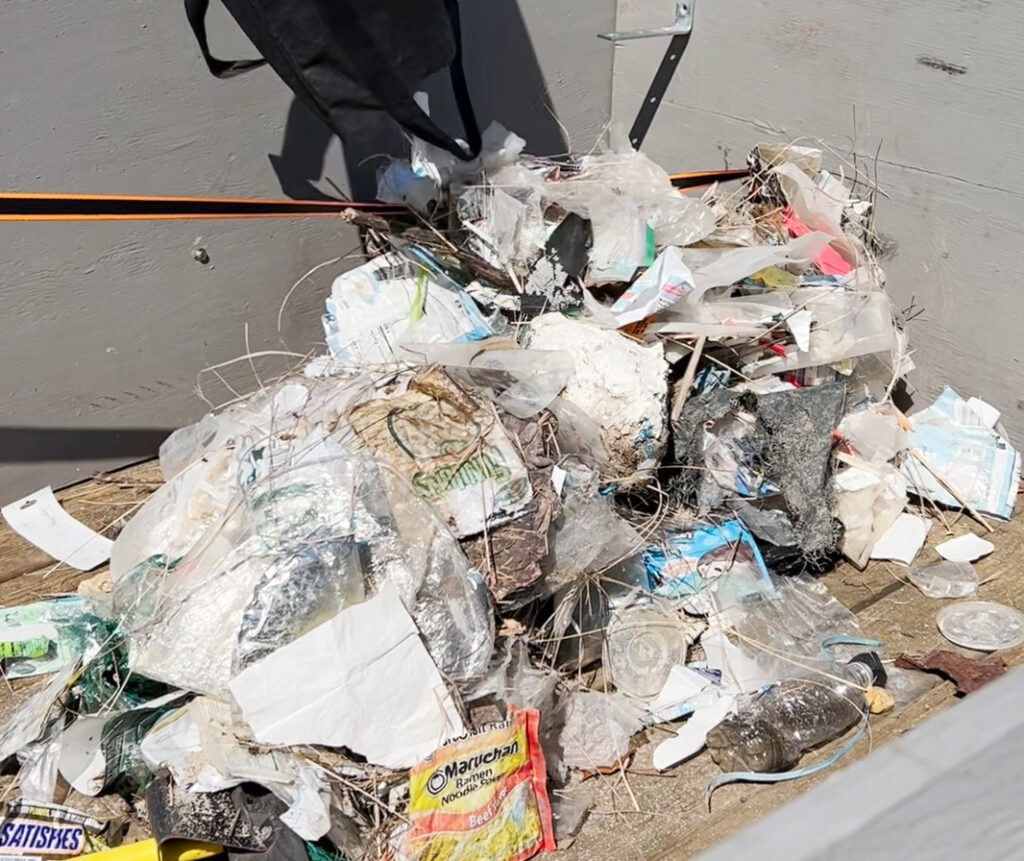25 years after preservation, Robins Island remains the ‘jewel of the Peconic’

It’s a rare person who sets foot on Robins Island, but in Southold Town at least, it’s also the rare person who doesn’t know of it.
The privately owned 437-acre island has passed through many hands over the centuries. But it’s only been the past quarter century that the preservation of the “jewel of the Peconic” has been a certainty. The 25th anniversary of a conservation easement protecting the land in perpetuity passed in mid-March.
The Nature Conservancy, a global conservation nonprofit, entered a conservation easement with island owner Louis Bacon in 1997. There are several at-risk species observed on the island, such as the endangered piping plover, threatened least tern and common tern and the rare seabeach knotweed. Nesting osprey pairs also successfully raised chicks on the island, with nine duos last counted in 2019, according to the conservancy.
“I wanted to continue the legacy of protection that previous generations had made so important for this unique and special island to remain in its natural state.”
Louis Moore Bacon
Conservation easements place legally enforceable restrictions meant to protect the natural features of a property, with landowners agreeing to donate or sell certain land rights. The property can still be sold, transferred or inherited, but future landowners are bound to the easement in perpetuity. Properties subject to easements may remain private.
“As the world contends with a growing biodiversity crisis, Robins Island, a 437-acre, mostly undeveloped property in the Peconic Estuary, possesses unique and significant natural and open space values,” said Joe Jannsen, conservation lands director for the Nature Conservancy in New York. “It provides a safe haven for multiple threatened and endangered animals and plants.”
According to Mr. Jannsen, Suffolk County added the island to its Open Space Acquisition List in 1986, declaring it a critical environmental area the following year. The New York Open Space Plan followed suit in 1992, identifying Robins Island among 75 “priority conservation projects” in the state, according to the conservancy.

Times Review reported in 1989 that Suffolk County put the island on a wish list of open land to purchase as far back as 1964, when it was owned by John Mackay of Locust Valley and run as a shooting preserve.
The island hosts a diverse range of habitats, including freshwater wetlands, coastal saltwater ponds, managed grasslands, intact forest and natural shoreline such as bluffs and sandy spits, which are “critically important for many species,” the conservancy said.
“By virtue of the easement, the Conservancy and the owner have the common purpose of conserving and protecting Robins Island in perpetuity as open space and a natural habitat of fish, wildlife, and plants,” Mr. Jannsen said. “The purpose of the easement is to ensure that the island remains predominantly undeveloped in a natural, open or forested condition; that endangered and threatened species are protected; and that activities on the island do not significantly impair or interfere with the conservation values of the island.”
The Nature Conservancy annually monitors the island for compliance, collecting biological data and submitting it to the state Department of Environmental Conservation for database inclusion and to inform future management decisions for at-risk species on the island.
Without the easement protecting the island from development, it’s possible that “native species and plants on eastern Long Island could have been lost,” Mr. Jannsen said. “Instead, Robins Island is a safe haven for threatened and endangered shorebirds including least terns, piping plover, sandpipers, and oyster catchers.”
Assemblyman Fred Thiele (I-Sag Harbor), for one, can certainly remember when there was a real danger of development on Robins Island. “The threat of development, especially given that point in time, was real and was imminent,” he said, reflecting on the struggle to protect the Peconic isle.
The lifelong Sag Harbor resident was, at that time, making his way through local and state government. He was elected to the county legislature in the late 1980s and then Southampton Town Supervisor in the early ’90s, before assuming his Assembly seat in 1995.
He recalled fighting alongside the other East End legislator, Greg Blass, at the time for land acquisition money from the county, which sought to acquire the island. Despite a “major effort,” there was never a willing seller, he said. Mr. Thiele credited Mr. Blass as the “chief champion for a public acquisition of Robins Island.”
“It is right smack in the middle of the Peconic Estuary system. Because of its location, it was one of the few land acquisition projects that I think all five [East End] towns had an interest in because it was right in the middle of the Peconic Bay,” Mr. Thiele said.
Algal blooms were starting to become an issue, he said, and there were other ongoing efforts to preserve the Peconic Estuary. But whether interest lay in protecting the estuary or land preservation in general, Mr. Thiele said, “the feeling was that Robins Island, because of its size, and because of its location, was a key acquisition.”
Other efforts to preserve Robins Island include a notable lawsuit from the Wickham family of Cutchogue in 1989. Robins Island Preservation Fund, a nonprofit dedicated to the island’s preservation, unsuccessfully sued the owners of the island at the time, arguing rightful ownership of an approximate 75% undivided interest as successor-in-interest to Parker Wickham.
Parker Wickham was stripped of his title to Robins Island in 1779 by New York State for his refusal to support the American Revolution. RIPF argued that New York had no sovereignty over the British-controlled Robins Island at the time and, furthermore, the state only took physical possession of Robins Island after a peace treaty that included a prohibition on confiscating British and Loyalist property was enacted in 1783.
The Mittermayer family of Germany owned the property at the time of the suit, under the name Southold Development Corporation. According to a 1992 article in Times Review, the family hoped to sell the property for $15.2 million to the Robis Corp. of California, which intended to build up to 20 multimillion dollar homes on five-acre mini-estates on the north and east shores. The other 375 acres were meant for preservation under a conservation easement, Times Review reported.

The New York Times, noting that Suffolk County had unsuccessfully tried to buy the island for several years, reported in 1989 that Robis backed out of the deal after learning of the title dispute and sued Southold Development. North Fork Bank and Trust also sued the Mittermayers for failing to pay $1.1 million in mortgage payments on the island and other properties, according to the 1989 article.
The Mittermayer family, which won the suit against RIPF in 1992, originally purchased the island in 1979 for $1.3 million with the initial intent to build luxury homes and later plans for a resort complex, Times Review reported in 1989.
The 1980s brought the “first big development boom out” to the East End, Mr. Thiele said. That was when, it seems, the twin forks were first discovered. “There was a lot of development pressure on the East End. In some ways, I think, as far as trying to protect the rural character of the area, local government in particular, I think we felt like we were under siege,” he said. “That’s why, I think people viewed Louis Bacon as such a breath of fresh air.”
Mr. Bacon, in fact, seemed to “ride in on a white horse,” Mr. Thiele said. He acquired the property and implemented a conservation plan, at no expense to taxpayers.
A conservationist philanthropist and private billionaire, Louis Bacon is the founder and co-chair of The Moore Charitable Foundation, which supports conservation nonprofits that protect threatened ecosystems. Robins Island was his first major conservation purchase in 1993.
Inspired by his father, who first introduced Mr. Bacon to the “great outdoors,” and the conservation commitment of entrepreneur Ted Turner, Mr. Bacon has undertaken a mission to “preserve and protect wildlife habitats and improve water systems for future generations,” he said in a Nature Conservancy donor profile. He has protected more than 214,000 acres of land in perpetuity across the U.S.
Robins Island in particular caught his attention after working on a charter fishing boat out of Montauk in the late 1970s.
“On my days off, I would waterski around Robins Island and loved the idea of an uninhabited natural island that had been long protected by hunters, starting with the Robins Island Club of 1888. When the property became available for purchase in the 1990s, as a sportsman myself, I wanted to continue the legacy of protection that previous generations had made so important for this unique and special island to remain in its natural state,” Mr. Bacon said in a statement to The Suffolk Times.
There are other pivotal preservation examples on the East End — Gardiners Island, for one — but Robins Island’s preservation was “really the cornerstone of protecting the Peconic Estuary,” and a turning point in the local battle for land preservation, according to Mr. Thiele.

“Robins Island, I would say, was a critical battle towards the recognition that we needed additional tools to protect the East End. I’m not sure we would have had the Community Preservation Fund if not for the lessons that we learned, in the battle to preserve Robin’s Island,” he said. The five East End towns maintain the Community Preservation Fund through a 2% real estate transfer tax to preserve farmland, open space and community character.
Previously, the open space program “was kind of ad hoc,” Mr. Thiele recalled. “It made us recognize that you can’t just do these one at a time, you need a comprehensive preservation program with a funding source.”
“The Community Preservation Fund first got introduced in the late 1980s. As I always say, it’s an overnight success that took us 10 years to get past the state legislature,” he said. “Those battles, Robins Island being one of the biggest ones, was definitely a turning point that led to these other preservation efforts, like the Community Preservation Fund … It’s not an accident that things like the Pine Barrens Act and the Community Preservation Fund and being included in the National Estuary Program all happened after Robins Island.”
Since Mr. Bacon entered the easement, conservation efforts on Robins Island have included replanting full-grown oak trees to replace those harvested for lumber years before, removing non-native grasses and reducing an overpopulation of deer.
Mr. Jannsen notes in the 25 years since the property was preserved, Robins Island has seen natural changes to its shoreline. The North Spit has grown significantly over the years, according to the conservancy, and the inlet to Robins Pond has moved several times, sometimes closing off from the bay completely.
With help from the town, there has also been a reduction in phragmites, or reed grasses, allowing native marsh plants like cattails to return, which in turn, has helped restore the populations of species such as the mud turtle. The conservation easement has prevented housing or other human development along the island’s coastline, Mr. Jannsen said. Times Review reported in 1997 that, at the time, the Robins Island easement was the largest ever conveyed to the Nature Conservancy on Long Island, covering all but 35 acres. In 1996, the Southold Zoning Board of Appeals approved a multi-million dollar design for restoring and enhancing the hunting facilities on Robin’s Island, and a new 15,000-square-foot vacation home and pool along the island’s southwest shore.
Mr. Bacon also held the necessary approvals for the restoration of two historic lodges and support buildings, as well as the construction of new structures such as a caretaker’s house, a boathouse and a recreation building, Times Review reported in 1997. A spokesperson for Mr. Bacon at the time said that although he had permission to add the new buildings, he wasn’t certain if he would.
Times Review reported in the same 1997 article that Mr. Bacon restored the Mackay house, named for a former owner and used during hunting outings, and planned to complete the Lane House, a partially completed structure abandoned over 75 years before. A July 2021 New York Post article reports: “Satellite images reveal two large estate homes on the island, what appears to be a caretaker’s home, a tennis court, a dock and thick woodlands.”
“We are thrilled that endangered and threatened species such as piping plover and least tern can continue to find refuge on Robins Island,” Mr. Jannsen said. “As the effects of climate change increase over the next 25 years, changes to the island habitat, plants, and animals are underway. However, we plan to continue monitoring [and adjusting] our work as necessary to preserve the biodiversity on Robins Island. Most likely, that means continuing to work with our colleagues around the world to address the serious threat of climate change that extends far beyond the shores of Robins Island or the Peconic Estuary, and which we are all vulnerable to.”








